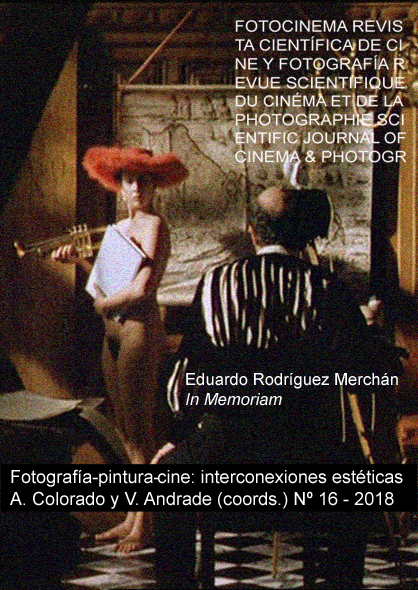The ontology of the hybrid image: Updating the ontological basis of André Bazin’s film theory
DOI:
https://doi.org/10.24310/Fotocinema.2018.v0i16.4095Keywords:
André Bazin, Film Theory, Ontology of the image, Hybrid Cinema, CGI, RealismAbstract
We are witnessing a rapid evolution of digital technology, to the extent that nowadays it is almost impossible for the average spectator to discern between live action and Computer-Generated Imagery. Such a development of its components brings about a theoretical problem: the so-called “death of cinema”. André Bazin’s theory has been constantly revisited because of his hypotheses on the ontology of the photographic image and its cinematographic implications. This paper aims to actualize Bazin’s thought, through the link between film and its materials as well as his arguments regarding cinema as an essentially realist medium. To do so, we’ll do a comparison between the three primary materials used to create pictures: optical images, both analogical and digital, and CGI. My final goal is to explore to what extent hybridization has transformed cinema from a Bazinian point of view.
Downloads
Metrics
Publication Facts
Reviewer profiles N/A
Author statements
Indexed in
-
—
- Academic society
- N/A
- Publisher
- Universidad de Málaga
References
Bresson, R. (1951). Journal d’un curé de campagne. Francia: UGC.
Cameron, J. (2009). Avatar. Estados Unidos: 20th Century Fox.
Cuarón, A. (2013). Gravity. Estados Unidos: Warner Bros., Esperanto Filmoj, Heyday Films.
Deren, M. (1943). Meshes of the Afternoon. Estados Unidos: Maya Deren Experimental Films.
Edwards, G. (2016). Rogue One: A Star Wars Story. Estados Unidos: Lucasfilm.
González Iñárritu, A. (2015). The Revenant. Estados Unidos: Regency Enterprises, RatPac-Dune Entertainment, Anonymous Content, M Productions, Appian Way.
González Iñárritu, A. (2014). Birdman or (The Unexpected Virtue of Ignorance). Estados Unidos: Regency Enterprises, New Regency Pictures, M Productions, Le Grisbi Productions, TSG Entertainment, Worldview Entertainment.
Jackson, P. (2002). The Lord of the Rings: The Two Towers. Alemania /Nueva Zelanda/ Estados Unidos: WingNut Films, The Saul Zaentz Company.
Jarmusch, J. (2016). Paterson. Estados Unidos: Amazon Studios, Animal Kingdom, K5 Film.
Jia, Z. (2004). Shijie. China: Office Kitano, Lumen Films, XStream Pictures, Bandai Visual Company, Bitters End, Dentsu, Shanghai Film Group, TV Asahi, Tokyo FM Broadcasting Co., Xinghui Production.
Johnson, R. (2017). Star Wars: The Last Jedi. Estados Unidos: Lucasfilm, Bad Robot.
Lowery, D. (2016). Pete’s Dragon. Estados Unidos: Walt Disney Pictures.
Nolan, Ch. (2010). Inception. Estados Unidos y Reino Unido: Warner Bros., Legendary Entertainment, Syncopy
Sharpsteen, B. (1941). Dumbo. Estados Unidos: Walt Disney Pictures.
Downloads
Published
How to Cite
Issue
Section
License
All contents published in Fotocinema Revista científica de cine y fotografía are protected under the Creative Commons Attribution-NonCommercial-ShareAlike 4.0 International (CC BY-NC-SA 4.0) license. All about this license is available in the following link: <http://creativecommons.org/licenses/by-nc-sa/4.0>
Users can copy, use, redistribute, share and exhibit publicly as long as:
- The original source and authorship of the material are cited (Journal, Publisher and URL of the work).
- It is not used for comercial purposes.
- The existence of the license and its especifications are mentioned.
There are two sets of authors’ rights: moral and property rights. Moral rights are perpetual prerogatives, unrenounceable, not-transferable, unalienable, imprescriptible and inembargable. According to authors’ rights legislation, Fotocinema. Revista científica de cine y fotografía recognizes and respects authors moral rights, as well as the ownership of property rights, which will be transferred to University of Malaga in open access. The property rights are referred to the benefits that are gained by the use or the dissemination of works. Fotocinema. Revista científica de cine y fotografía is published in an open access form and it is exclusively licenced by any means for doing or authorising distribution, dissemination, reproduction, , adaptation, translation or arrangement of works.
Authors are responsable for obtaining the necessary permission to use copyrighted images.














13.png)



